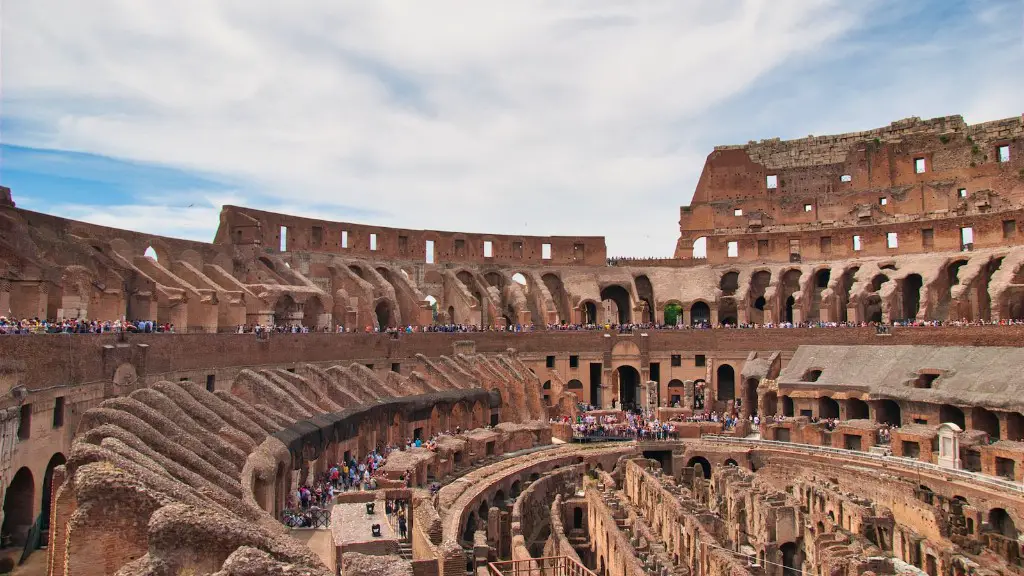Currency Used in Ancient Rome
The coins that were used in Ancient Rome were called Aes. There were two types of coins, namely the Aes Grave and the Aes Signatum, which were both made from bronze or copper and were quite heavy. The value of the coins varied depending on the weight, size and shape of the coins. For example, the Aes Signatum coins were stamped with the image of a god or goddess, while the Aes Grave coins were not.
In addition, Roman officials also minted coins of gold and silver which had greater value than bronze or copper coins. Silver denarii were common for everyday purchases, while gold aurei were mostly used for large transactions and as a store of value. The most common denominations of coins were the dupondius, the quadrans and the assis.
In ancient Rome, currency was also used for trade. Merchants and traders accepted different types of coins from different parts of the Roman Empire, such as copper coins from Phrygia or silver coins from Hispania. This type of currency greatly facilitated commerce and trade in the ancient world.
In addition to coins, Roman officials used other methods to acquire goods and services. They could use tax revenue, treasury bonds or requisition payments in times of emergency or military campaign. Moreover, some emperors used their own personal wealth to fund public works projects like the construction of aqueducts, roads or other infrastructure.
The economy of the Roman Empire relied on a variety of currencies. Although coins were the most important currency in ancient Rome, other forms of payment were also used. Money lenders and merchants used credit instruments such as tabulae commendaticiae, deposits, loans and usury.
Furthermore, barter also played an important role in the economy of the Roman Empire. Barter meant that citizens could trade goods for goods. It allowed for people to trade goods without the need of currency. This could be seen in markets where people were bartering goods or services in exchange for other goods or services.
The use of currency in ancient Rome was always evolving. The Roman coins were issued by the emperor and were constantly changing due to new denominations, new metal amalgams, and more artistic designs. This allowed the Roman Empire to thrive and become one of the most prosperous of its time.
The Role of Currency In Ancient Rome’s Economy
The role of currency in ancient Rome’s economy was of utmost importance. Coins served both as a medium of exchange as well as a unit of account. As a medium of exchange, coins allowed for the movement of goods and services as well as for people to make payments. As a unit of account, coins made trading easier as there now was a unit which people could refer to when setting prices or estimating the value of goods.
The use of coins in ancient Rome also contributed to the development of the Roman state. It was an effective way of collecting taxes and financing the military campaigns and other Roman adventures. Coins were also used as a way to reward Roman soldiers and citizens for their loyalty and services to the Roman state.
Another important role of coins in the Roman Empire was to spread Roman culture. Coins with the head of the emperor or goddesses were made to spread Roman culture by portraying religious beliefs, showing loyalty to the emperor or the gods, and displaying the military accomplishments of the emperor. This was part of the Roman policy of Romanization.
The Roman Empire also used coins to consolidate its power. The use of coins made it easier for the Romans to maintain control over their colonies and helped to create a unified system across the provinces. Coins were also used to a certain extent by other political states in the Mediterranean region, such as the Greeks and the Persians.
The coins of the Roman Empire were widely used and accepted. This allowed for business to be conducted on a wide scale and helped the Roman economy grow. The coins could be exchanged at the banks in the province or at the emporium in Rome. The coins also had a fixed monetary value and were stable in value, which allowed for easy trading.
The Decline Of The Currency In Ancient Rome
The decline of the currency in ancient Rome was due to various factors. The most important factor was the decline of the Roman Empire itself. As the economy of the Roman Empire weakened, so did the value of the coins, which led to widespread inflation. This was further compounded by the debasement of the coins, in which the coins were made out of cheaper and less valuable metals.
Another factor in the decline of the Roman currency was the collapse of the banking system. This collapse, in turn, led to a decrease in the money supply and, eventually, to a decrease in the amount of coins in circulation. The fall of the Roman Empire also contributed to the decline of the currency, as the Romans were no longer able to frequently mint new coins.
The great fire of Rome in 64 CE also had a significant impact on the Roman currency. The fire destroyed many of the buildings where the coins were stored and minted. This put a strain on the economy and, as a result, the value of coins was further weakened.
The rise of Christianity also had an effect on the Roman currency. Christianity frowned upon the use of coins, as it was believed to lead to greed and inequality. This led to people hoarding the coins, which further decreased the money supply and put a strain on the Roman economy.
In conclusion, the currency of ancient Rome played an important role in the economy of the Roman Empire and allowed for trade and commerce to take place on a large scale. However, due to various factors, such as the fall of the Roman Empire and the rise of Christianity, the coinage of ancient Rome eventually declined and the Roman currency was replaced by other forms of money.
Alternative Methods of Currency in Ancient Rome
The Aes were not the only form of currency used in ancient Rome. In addition to coins, Roman officials used other methods to acquire goods and services. Apart from the coins minted in Rome, other forms of money included tabulae commendaticiae, treasury bonds, requisition payments, and loans.
Tabulae commendaticiae were promissory notes issued by the Roman government to contractors and lenders. These notes promised to pay back the debt of the Roman government at a future date. Treasury bonds were also issued in order to finance military campaigns or to make payments for the building of public works projects.
The Roman army also used requisition payments to acquire food, supplies, and services. These payments were collected from local citizens in the form of money or goods. Loans were also used in ancient Rome as a form of currency. Money lenders and merchants flourished in this era as they were able to loan money at high interest rates.
Barter was another form of currency used in ancient Rome. Barter meant that citizens could trade goods for goods. This allowed exchange of goods without the use of money. Such transactions could be seen in the markets where people bartered goods or services in exchange for other goods or services.
The use of currency in ancient Rome was always changing and evolving. Official coins, loan payments, and barter were all part of the Roman monetary system. These different forms of currency helped to facilitate trade and commerce in the Roman Empire.
Types of Coins Used in Ancient Rome
The most common form of currency used in the Roman Empire was coins. The coins in circulation in ancient Rome were mainly made of bronze and copper, but some were made of gold and silver. The most common denominations of coins were the as, dupondius, and quadrans.
The as, or Aes, was the largest denomination of coins and was made of either bronze or copper. The Aes Signatum coins were stamped with an image of a god or goddess on one side and with an inscription on the other side. The Aes Grave coins did not feature any such inscription or image. Smaller denominations of coins included the dupondius, which was a half an as, and the quadrans, which was one fourth of an as.
In addition to copper and bronze coins, Roman officials also minted coins of gold and silver. Gold aurei were mainly used for large transactions and as a store of value, while silver denarii were more commonly used for everyday purchases.
The coins used in ancient Rome served a variety of functions. They were used to pay taxes, finance military campaigns, and reward Roman soldiers and citizens for their loyalty and services. Coins were also used as a way to spread Roman culture, as coins were often adorned with images of gods and goddesses, as well as depicting the military accomplishments of the emperor.
In conclusion, the coins of the Roman Empire had both monetary and cultural value, and played an important role in the economic success of the Roman Empire. Coins enabled a unified system of payment and exchange, and made trade and commerce easier. The coins of the Roman Empire, with their varying weights, sizes and designs, were used for centuries, allowing the Roman Empire to prosper and become one of the most powerful of its time.





